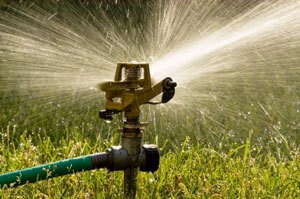
Your lawn requires more water to maintain than any other part of your garden. Its overall health depends on how much water it receives. So how do you know how much to water and how often? Here are the basics to watering your lawn.
The best time of day to water your lawn is early in the morning or early in the evening. This is because temperatures are lower and there is generally less wind, so less water is lost to evaporation, allowing water to penetrate more deeply into the soil.
Severe drought can kill a lawn, but so can too much water. In general, most established lawns need between 1 to 1 1/2 inches of water per week either by rainfall or in combination with irrigation. This 1-inch of water will soak into the soil 4 to 6 inches and reach the roots. Turf species and soil type both play a role in determining how much water your lawn needs. For example, sandy soils need to be watered more often than clay soils, but it takes less water to wet them to a 4-inch depth. Seasonal conditions also play a role in how much water grass needs. All types of grass require less water in cooler weather.
Water your lawn as soon as it starts to dry out. You can tell that your lawn is getting dry when the grass starts to develop a blue-gray tint and doesn't bounce back within a few seconds after walking on it. You can also use a screwdriver to probe your soil. If it goes in easily 4 to 6 inches deep, the soil is wet enough. If you meet a lot of resistance, it's probably time to water again.
Your lawn will be healthier if you water it only when it really needs watering. Watering heavily and infrequently is a much better way to develop a deep-reaching root system than watering lightly and frequently. Deep roots utilize moisture farther down in the soil and are more resistant to drought.
An easy way to calculate the amount of water your lawn is receiving is to place a rain gauge at the mid-point between the irrigation system and its outermost wet perimeter. Turn on the sprinkler for 30 minutes and then use the scale on the rain gauge to determine how much water your lawn has received.
Soak rates vary according to soil type. To figure out approximately how long you need your system to run, use this helpful chart created by the Better Lawn and Turf Institute as a guide to how long it will take water to soak into your soil to a depth of 4 to 6 inches.
| Soil Type | Depth of Infiltration | Soak Time Per Hour Time for 1 inch of Water to Soak In. |
| Sand | 2.0 inches | 1/2 hour |
| Sandy Loam | 1.0 inches | 1 hour |
| Loam | 0.5 inches | 2 hours |
| Silt Loam | 0.4 inches | 2 hours 15 minutes |
| Clay Loam | 0.3 inches | 3 hours 20 minutes |
| Clay | 0.2 inches | 5 hours |
Source: Better Lawn and Turf Institute
Dormancy is nature's way of protecting your lawn from mid-summer heat and drought. Grass blades turn brown and your lawn suddenly appears to be on its way out. This dormant state doesn't usually lead to the death of your lawn unless it is extended for a prolonged period of time, or your lawn was unhealthy to begin with. Under "normal" circumstances, when the weather breaks and adequate moisture returns, your grass will turn green again and resume growth.You can help prevent summer dormancy from occurring by doing the following:

About The Author: Ellen Brown is an environmental writer and photographer and the owner of Sustainable Media, an environmental media company that specializes in helping businesses and organizations promote eco-friendly products and services. Contact her on the web at http://www.sustainable-media.com
Add your voice! Click below to comment. ThriftyFun is powered by your wisdom!